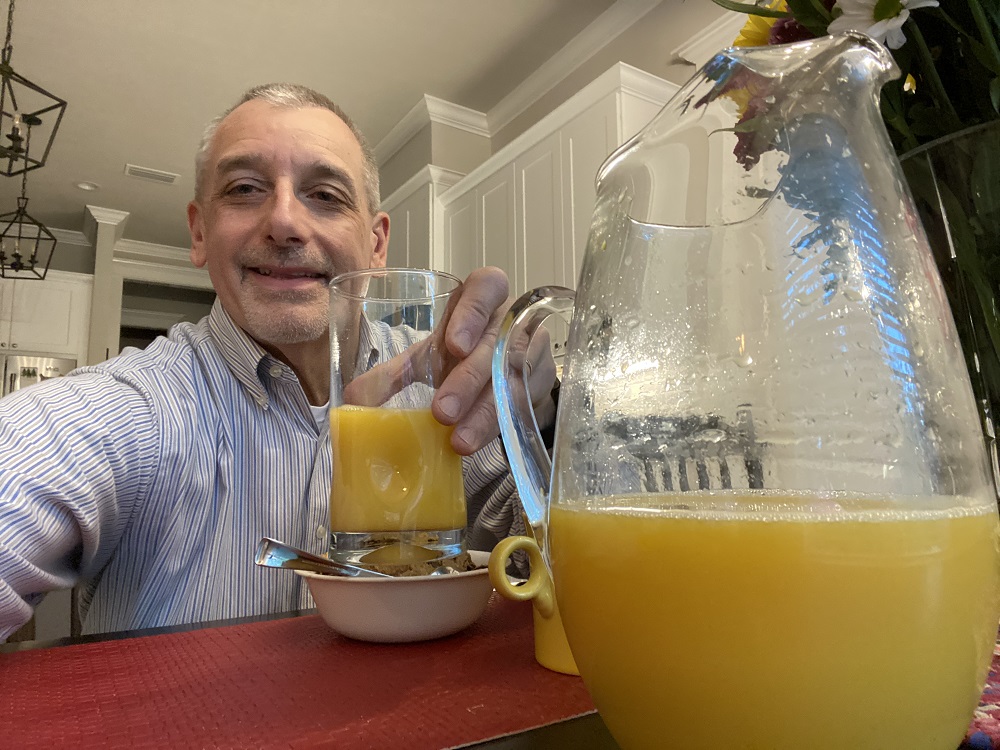May 4 is National OJ Day, a good time to take a closer look at what goes into a glass of Florida orange juice. Because there’s a lot in that glass of OJ—a lot of money, a lot of science, a lot of hard-working people dedicated to getting it to your breakfast table.
There’s also gratitude—this year, the Florida Department of Citrus is celebrating National OJ Day by toasting the frontline workers—the doctors, nurses, law enforcement and other essential workers, including farmers—who are risking themselves in the battle against COVID-19. This May 4, you can thank our frontline workers by raising a glass of OJ and posting it online with the hashtag #NOJD2020. Visit https://www.floridacitrus.org/grower/industry-resources/ for more information.

Most orange juice comes from Florida, where citrus is a major component of the state’s agriculture. Each year, citrus growing, processing and allied industries make an $7.2 billion impact on Florida’s economy and support roughly 27,000 full time and part time jobs.
Oranges are so synonymous with Florida that you would think they were easy to grow here. But in fact, growing citrus in Florida is a constant struggle against the elements, including freezes and hurricanes, plant diseases, pests, poor soil, and fluctuations in the market. It takes determination, hard work, and nerves of steel to be a citrus grower in Florida. It also takes a massive effort from researchers and Extension agents from UF/IFAS and other institutions to help growers overcome the obstacles that stand between their groves and your morning glass of OJ.
Citrus trees are vulnerable to many pests, plant diseases, and nutrition deficiencies. Ask a Florida citrus grower what keeps them awake at night and they’ll tell you about citrus greening. Also known as HLB, citrus greening is a disease that weakens trees and reduces their yield. Since 2005, when it was first reported in Florida, HLB has infected nearly every commercial grove in the state and has had a devastating effect on the whole citrus industry. UF/IFAS researchers and Extension faculty are leading an all-out effort to help growers manage the disease and keep Florida OJ flowing. Promising solutions range from improving plant nutrition at the root zone to protecting tree canopies against the Asian citrus psyllid, which spreads the disease.
Commercial citrus trees are cultivated from two parts—a rootstock, which is planted into the ground, and a scion, which is grafted onto the trunk of the rootstock. Growers want to pair the most resilient rootstocks with the scions that yield the best fruit. Citrus breeding programs at both the USDA and UF/IFAS continue to develop promising new citrus cultivars with higher tolerance to HLB and the sweet, tart flavor consumers crave. Flavor researchers at the UF/IFAS Citrus Research and Education Center in Lake Alfred are discovering the secrets behind the natural sweeteners in citrus that may enhance the flavor of Florida orange juice and make it more nutritious.
Hamlin and Valencia varieties are most often used for orange juice. They grow through the summer and fall and are harvested between October and June. This just happens to coincide with some of Florida’s roughest weather seasons. A hurricane or sudden freeze can wipe out a whole year’s crop overnight. When freezing weather is imminent, growers will turn up the sprinklers to coat their fruit in ice, which actually stabilizes its temperature at a safe 32 degrees F. Knowing exactly when to do this will not only save a grower’s orange crop, but thousands of dollars in irrigation costs. To be ready for these events, growers rely on UF/IFAS Extension weather services. The Florida Automated Weather Network (FAWN) is a system of localized weather stations dotted throughout Florida’s agricultural areas that provide up-to-the minute information about dew point, temperature, relative humidity and other factors growers need to monitor. Through Winter Weather Watch, established by UF/IFAS Extension about 50 years ago, Florida citrus growers can get weather information and expertise on how to protect their fruit from a freeze.
With the help of science and a bit of luck, a grower’s crop is safely harvested and processed into that glass of morning sunshine we call orange juice. One-hundred-percent orange juice isn’t just delicious, it’s also an excellent source of Vitamin C, as well as potassium, folate and thiamin. Now is an especially good time to take care of ourselves, and nutrition experts at UF/IFAS Extension can help you learn how to incorporate orange juice and other citrus products into a well-balanced diet.
So as you can see, there’s a lot squeezed into your glass of Florida orange juice, and UF/IFAS is dedicated to making sure that everyone from growers to consumers can count on OJ at the table every day.
To learn more about orange juice and Florida citrus, visit the UF/IFAS Citrus Research and Education Center at https://crec.ifas.ufl.edu/.

 0
0
